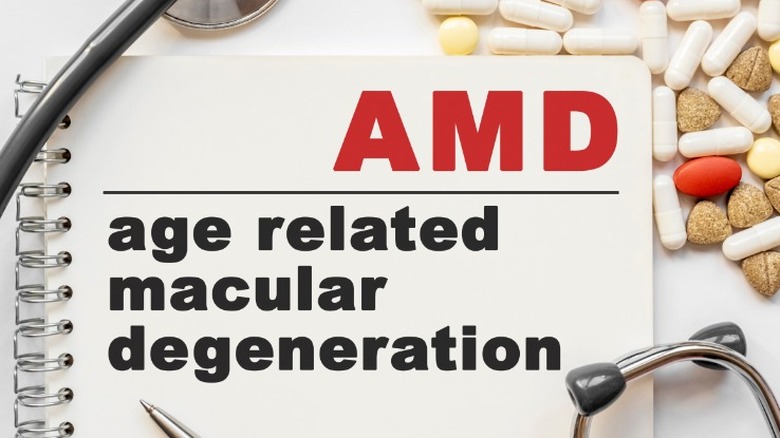How 2 Eye Diseases Can Affect The Progress Of Age-Related Macular Degeneration
As we age, the risk of vision loss increases. According to MedlinePlus, 8% of older people globally show indications of age-related macular degeneration. Of that population affected by age-related macular degeneration, around 11 million of them are Americans. Age-related macular degeneration is an eye disease that impacts your central vision. Central vision helps you to do focused tasks like cooking, driving, reading, and even discerning people's faces. Changes in vision can begin in your 40s and become more prominent in your 60s and 70s. Unfortunately, vision loss can get worse over time, but won't lead to complete blindness (per National Eye Institute).
There are two main types of age-related macular degeneration: wet and dry. Dry age-related macular degeneration (AMD), or atrophic AMD, occurs as the macula thins over time and slowly progresses over early, intermediate, and late stages. There may not be any symptoms for early stage dry atrophic AMD, but the intermediate stage may bring on symptoms like blurred vision and issues seeing in certain lighting. Wet AMD, or advanced neovascular AMD, causes rapid vision loss as blood vessels grow behind the eye and impair the macula. Late stage wet or dry AMD can bring on symptoms like blank spots and issues seeing color. A recent study has identified two diseases that may contribute to age-related macular degeneration.
Can these 2 diseases contribute to the development of age-related macular degeneration?
A 2023 study published in the journal Eye contributed to the knowledge base of age-related macular degeneration. The researchers found that drusen and subretinal drusenoid deposits are distinct types of deposits that can potentially contribute to age-related macular degeneration.
Healthline notes that drusen are minute yellow-colored deposits made of lipids and proteins. Drusen deposits can occur between the retina and the blood vessels that bring blood to the retina. On the other hand, subretinal drusenoid deposits occur beneath the retina and cause more damage than drusen. For example, subretinal drusenoid deposits are related to life-threatening vascular diseases — such as cerebrovascular disease or cardiovascular disease.
Some health experts note that drusen and subretinal drusenoid deposits — which may contribute to the progression of age-related macular degeneration — can result from a build-up of waste in the retina, chronic inflammation, and injury to the cells that aid the retina.


